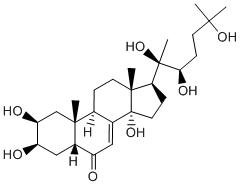
20-Hydroxyecdysone (ecdysterone or 20E) is a naturally occurring ecdysteroid hormone which controls the ecdysis (moulting) and metamorphosis of arthropods. 20-Hydroxyecdysone is also found most abundantly in plant species and has anabolic effects in vertebrates, i.e. increasing muscle size without androgen influence. 20-Hydroxyecdysone is produced from ecdysone (E) by the action of a P450 monooxygenase that hydroxylates E at carbon 20. When shade (shd, Drosophila P450 enzyme) is transfected into Drosophila S2 cells, extensive conversion of ecdysone (E) to 20-Hydroxyecdysone is observed. 20-Hydroxyecdysone regulates gene expression by binding to a nuclear receptor heterodimer, consisting of the ecdysone receptor (EcR) and ultraspiracle proteins (USP), which are orthologs of the vertebrate LXR and RXR receptors, respectively. Genes regulated by 20-Hydroxyecdysone, and dependent on EcR, account for many transcripts that are significantly up- or downregulated at puparium formation. 20-Hydroxyecdysone plays a key role in insect development, cell proliferaton, growth and apoptosis by controlling gene expression. 20-Hydroxyecdysone may protect PC12 cells against CoCl2-induced cell injury by inhibiting ROS production and modulating components of the mitochondrial apoptosis pathway. Many genes regulated by 20-Hydroxyecdysone in Kc167 cells are not regulated by 20-Hydroxyecdysone in salivary glands of wandering 3rd instar larvae, and 20-Hydroxyecdysone-induced levels of EcR isoforms EcR-RA, ER-RC, and EcR-RD/E differ between Kc cells and salivary glands suggesting a possible cause for the observed differences in 20-Hydroxyecdysone-regulated gene transcription between the two cell types. 20-Hydroxyecdysone is a potential fibrosis antagonist for renal proximal tubule cells through suppressing post-receptor signaling of TGF-β1 and restoring tubule epithelial character by blocking the expression of Snail.

BMC Biol. 2024 Mar 6;22(1):54.
A CTL − Lys immune function maintains insect metamorphosis by preventing gut bacterial dysbiosis and limiting opportunistic infections
20-Hydroxyecdysone purchased from AbMole
| Molecular Weight | 480.63 |
| Formula | C27H44O7 |
| CAS Number | 5289-74-7 |
| Solubility (25°C) | DMSO 76 mg/mL |
| Storage | -20°C, protect from light, sealed |
| Species | Mouse | Rat | Rabbit | Guinea pig | Hamster | Dog |
| Weight (kg) | 0.02 | 0.15 | 1.8 | 0.4 | 0.08 | 10 |
| Body Surface Area (m2) | 0.007 | 0.025 | 0.15 | 0.05 | 0.02 | 0.5 |
| Km factor | 3 | 6 | 12 | 8 | 5 | 20 |
| Animal A (mg/kg) = Animal B (mg/kg) multiplied by | Animal B Km |
| Animal A Km |
For example, to modify the dose of Compound A used for a mouse (20 mg/kg) to a dose based on the BSA for a rat, multiply 20 mg/kg by the Km factor for a mouse and then divide by the Km factor for a rat. This calculation results in a rat equivalent dose for Compound A of 10 mg/kg.
[3] Xiaoli Jin, et al. 20-Hydroxyecdysone-responsive microRNAs of insects
| Related Estrogen Receptor Products |
|---|
| hFSH-β-(33-53) TFA
hFSH-β-(33-53) TFA, a thiol-containing peptide which corresponds to a second FSH receptor-binding domain, is a FSHR (follicle-stimulating hormone receptor) antagonist. hFSH-β-(33-53) TFA inhibits binding of FSH to receptor and is a partial agonist of estradiol synthesis in Sertoli cells. |
| Yp537
Yp537 is an estrogen receptor (ER) inhibitor that blocks dimerization of the human estrogen receptor. |
| Palazestrant
Palazestrant is a novel, orally active, estrogen receptor antagonist and selective estrogen receptor degrader. It can be used in studies related to ER+/HER2+ breast cancer. |
| Acolbifene hydrochloride
Acolbifene hydrochloride is an active metabolite of EM800 and an orally available, selective estrogen receptor modulator (SERM) that inhibits estradiol-induced ERα (IC50 = 2 nM) and ERβ (IC50 = 0.4 nM) transcriptional activity, has significant anti-estrogenic effects on the mammary gland and uterus, and has anticancer activity. possesses anticancer activity. |
| Acolbifene
Acolbifene is an active metabolite of EM800 and an orally active pure anti-estrogen and selective estrogen receptor (ER) antagonist that inhibits estradiol-induced ERα (IC50 = 2 nM) and ERβ (IC50 = 0.4 nM) transcriptional activity and has anticancer activity. |


Products are for research use only. Not for human use. We do not sell to patients.
© Copyright 2010-2023 AbMole BioScience. All Rights Reserved.
